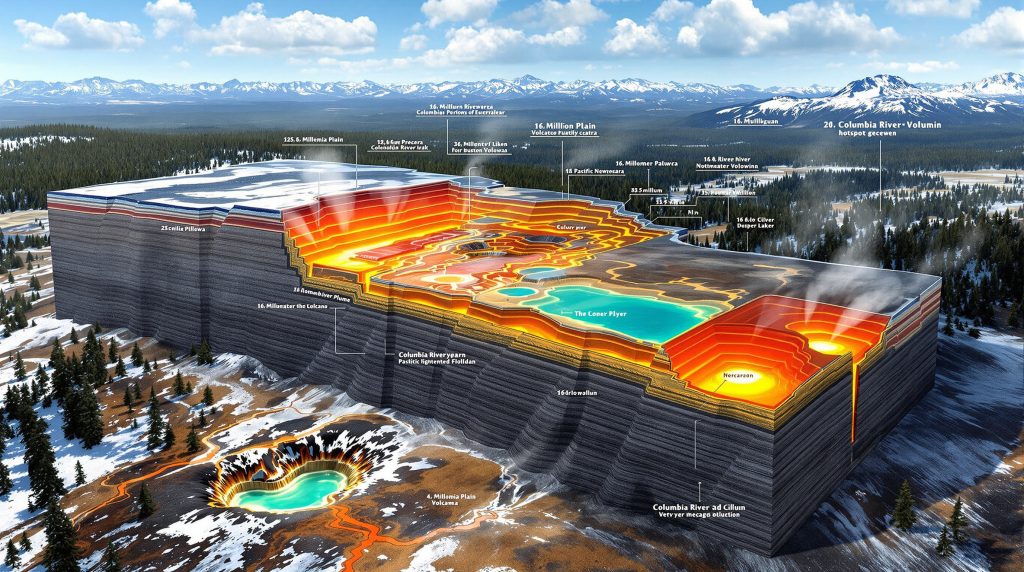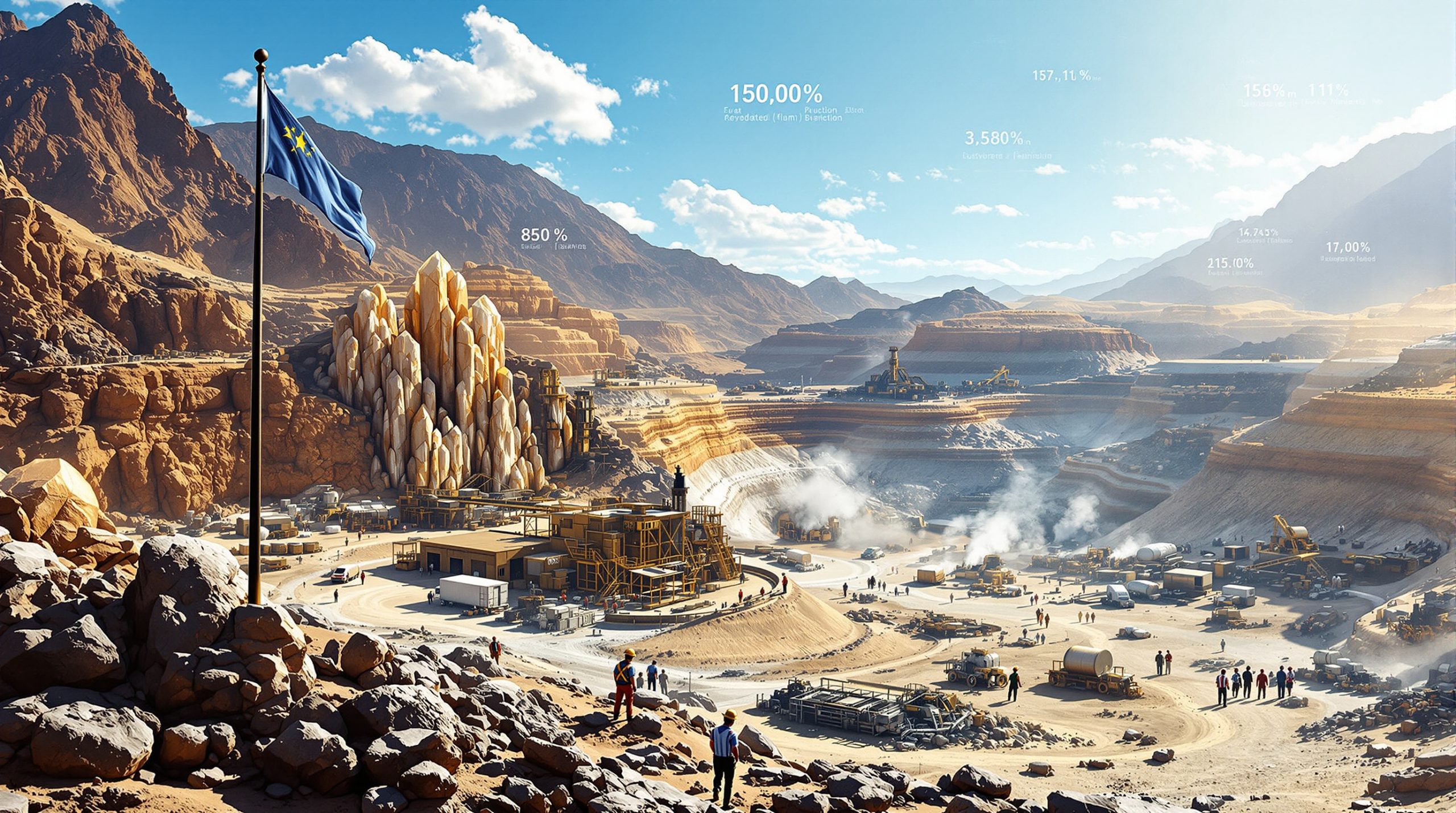Understanding the Yellowstone Hotspot's Role in Shaping Pacific Northwest Geology
The Yellowstone hotspot represents one of Earth's most significant geological phenomena, fundamentally shaping the landscapes of the Pacific Northwest over millions of years. This deep mantle plume has created an extraordinary geological legacy that extends far beyond the famous geysers and hot springs of Yellowstone National Park, influencing terrain formation, volcanic activity, and landscape evolution across Oregon, Washington, and beyond.
Recent advances in geological understanding have revealed the hotspot's profound influence on regional geology. What began as a controversial hypothesis in the late 1970s has evolved into a comprehensive framework explaining much of the Pacific Northwest's complex geological history. The evidence now demonstrates that this single mantle plume has been responsible for massive flood basalts, terrain accretion processes, and ongoing volcanic activity spanning 16.5 million years.
The Fundamental Nature of Hotspot Volcanism
The Yellowstone hotspot operates through fundamentally different mechanisms than typical plate boundary volcanism. While most volcanic activity occurs at tectonic plate margins, hotspots originate from deep within the Earth's mantle, potentially at the core-mantle boundary approximately 2,900 kilometers below the surface. These mantle plumes rise through the overlying rock due to thermal buoyancy, creating long-lived volcanic systems that remain relatively stationary as tectonic plates move overhead.
Key characteristics distinguishing hotspot volcanism include:
• Temperature conditions: Mantle plume temperatures reach 1,500-1,600°C, significantly hotter than typical mantle temperatures
• Geochemical signatures: Distinct isotopic compositions reflecting deep mantle sources, particularly elevated helium-3 ratios
• Volcanic patterns: Creation of age-progressive volcanic chains as plates move over stationary plumes
• Eruption volumes: Capacity for producing massive flood basalt provinces covering thousands of square kilometers
The hotspot's initial emergence occurred 16-17 million years ago at the Oregon-Nevada-Idaho border region. This timing coincides with the beginning of Columbia River Basalt volcanism, establishing the connection between deep Earth processes and surface geological phenomena that would reshape the entire Pacific Northwest.
Timeline of Regional Transformation
The progressive migration pattern of hotspot influence reflects North American Plate movement in a southwest direction over the stationary mantle plume. Smith Rock formation, dated at 30 million years old, represents early hotspot activity, while the Columbia River basalts at 16 million years mark the beginning of the major flood basalt episode.
The Awahee volcanics, historically estimated at 14 million years old, demonstrate continued hotspot influence as the plate moved overhead. Most recently, Cinder Butte at 800,000 years old potentially represents the youngest hotspot manifestation in Oregon, suggesting ongoing plume tail activity even as the main thermal center has migrated to its current Yellowstone position.
Formation Mechanisms of the Columbia River Basalts
The Columbia River Basalts represent one of Earth's youngest and best-preserved flood basalt provinces, covering approximately 164,000 square kilometres across the Pacific Northwest plateau. These massive lava flows originated from extensive dike systems that tapped directly into mantle plume-derived magmatic deposit formation chambers.
Dike Swarm Distribution and Characteristics
Three major dike swarms distributed the basaltic magma across the region:
• Chief Joseph Dike Swarm: The most extensive system, particularly visible in the Wallowa Mountains due to contrasting colors between white metamorphic rocks and dark basaltic intrusions
• Monument Dike Swarm: Located in central Oregon, feeding flows in the Monument and Strawberry Mountain areas
• Steens Mountain dikes: Southern Oregon system connecting to the initial hotspot emergence zone
The anastomosing or crisscrossing dike patterns in the Wallowa Mountains demonstrate the complex pathways magma followed through pre-existing joint systems. These intrusions show clear temporal relationships, with Imnaha dikes crossed by younger Grande Ronde dikes, documenting the progressive nature of flood basalt emplacement.
Research suggests that terrain boundaries provided preferential conduits for ascending basaltic magma. The complex structural deformation within accreted terrains created abundant fracture systems, offering what geologists describe as "happy places for basalt that wanted to get to the surface."
Revolutionary Understanding of Rhyolitic Components
A landmark shift in understanding occurred approximately three years ago when researchers redefined materials previously excluded from the Columbia River Basalt Group. The "Columbia River Rhyolites" concept, established through detailed geochemical analysis, demonstrates that these silicic rocks represent crustal melting above Columbia River basalt holding magma chambers.
Key rhyolitic formations now linked to hotspot activity include:
• Dinner Creek Tuff: Travelled approximately 100 miles from eruption source north of Hereford, welding together near Richland, Oregon
• Strawberry andesites: Calc-alkaline compositions previously puzzling due to absence of nearby subduction zones
• Awahee calderas: Multiple caldera systems in the Owyhee area showing bimodal volcanism
• Dooley Mountain rocks: Additional examples of crustal melting processes
The Dinner Creek Tuff exemplifies the scale of these eruptions, originating from rocks situated directly above very large Grande Ronde holding chambers. Multiple calderas developed in this region, with Ironside Mountain representing one component of the larger caldera complex.
Terrain Accretion and Structural Assembly
The Blue Mountains terrains represent some of North America's most complex accreted geological units, assembled through collision processes spanning 125-110 million years ago. Recent advances in paleomagnetic analysis have revolutionised understanding of these terrains' origins and assembly mechanisms.
Paleomagnetic Evidence for Distant Origins
Advanced drilling techniques applied to Permian sediments in Hells Canyon have provided compelling evidence for Mexican latitude origins of Blue Mountains terrains. These paleomagnetic studies analyse magnetic inclination data from drill cores, revealing original depositional latitudes significantly south of current positions.
The accuracy of paleomagnetic methods has improved dramatically over recent decades. What were once sceptically called "paleo magicians" results have evolved into scientifically verifiable data through refined analytical techniques and improved understanding of magnetic mineral behaviour.
The three distinct granitic rock age groups reflect progressive collision processes:
| Age Group | Timing (Million Years) | Formation Mechanism |
|---|---|---|
| Group 1 | 160-150 | Collision of Wallowa and Olds Ferry arcs while offshore |
| Group 2 | 148-130 | Stitching plutons after arc collision, before accretion |
| Group 3 | <100 | Post-collision granitic intrusions (Cornucopia/Idaho batholith) |
Structural Deformation and Suture Zone Characteristics
The Salmon River suture zone and Western Idaho shear zone preserve remarkable records of terrain collision intensity. Double folds, if not triple folds document the extreme compression experienced during accretion processes. Boudinage structures demonstrate stretching and breaking of more competent granitic veins within less competent metamorphic host rocks.
Rotated garnets, approximately quarter to half-inch in diameter, provide quantitative measures of shearing intensity and rotation during collision. These metamorphic minerals preserve internal structures that document the progressive deformation history, offering precise indicators of the forces involved in terrain assembly.
Distinctive limestone formations near Durkee, Oregon present ongoing mysteries. Gigantic limestone pinnacles immersed in seas of phyllite create what researchers describe as "limestone stew." Isotopic evidence and metamorphic grade variations suggest these may represent additional, previously unidentified terrains mixed into the Blue Mountains assemblage.
Snake River Plain Evolution as Hotspot Track
The Snake River Plain represents the clearest expression of hotspot track development, demonstrating the systematic age progression as the North American Plate moved southwest over the stationary Yellowstone mantle plume. This parabola-shaped uplift pattern documents the thermal influence extending beyond the immediate volcanic centres.
Caldera Formation and Bimodal Volcanism
Progressive caldera development characterises the hotspot track evolution. Each major volcanic centre developed multiple calderas through repeated eruption cycles, with subsidence mechanisms following hotspot passage as thermal support diminished.
The bimodal volcanism patterns throughout the Snake River Plain reflect the complex interaction between basaltic and rhyolitic magma systems. Castle Butte along the Owyhee River exemplifies this pattern, displaying alternating layers described as "chocolate and vanilla all mixed together" – tuffs alternating with basalt flows in repetitive sequences.
Modern Yellowstone represents the culmination of this evolutionary process, positioned where the hotspot enjoys "a much more coherent path to the surface even though it's longer and produces more calderas." The current configuration allows for more efficient magma transport from deep mantle sources, explaining Yellowstone's exceptional volcanic productivity.
Welded Tuff Formation and Distribution
Welded tuff deposits throughout the region document the explosive nature of silicic volcanism associated with hotspot activity. The extensive travel distances of these pyroclastic flows demonstrate the scale of individual eruptions, with materials maintaining sufficient temperature over 100-mile transport distances to weld together upon deposition.
Wesley Gulch dikes show remarkable similarities to Smith Rock dike systems, representing equivalent processes separated by 14 million years. These post-caldera or syn-caldera intrusions document the repetitive nature of hotspot volcanic processes across the temporal sequence.
Broader Landscape Implications and Regional Effects
The hotspot's influence extends far beyond direct volcanic manifestations, fundamentally altering regional geology through tectonic rotation, basement delamination, and structural reactivation across Washington, Oregon, and southern British Columbia.
Cascade Range Interactions and Structural Modifications
Collision with the Silesia oceanic plateau approximately 50 million years ago initiated widespread geological reorganisation. This encounter triggered:
• Separation of sedimentary basins in western Washington (Chuckanut and Swauk basins)
• Activity along the Straight Creek fault system
• Formation of metamorphic core complexes including kettle dome and Okanagan dome
• Development of the Colville batholith and associated granitic intrusions
• Republic graben rhyolites and gneisses in the North Cascades region
The flat subduction of Farallon and possibly Kula plates beneath North America created conditions for extensive calc-alkaline volcanism in areas lacking active subduction zones. This process generates adakites, Icelandites, and other unusually composed materials through mantle plume interaction with defunct but still-present subducted oceanic lithosphere.
Wallowa Mountains Uplift Through Basement Delamination
Recent research has documented a revolutionary mechanism for Wallowa Mountains uplift through basement delamination. The hotspot essentially melted off the eclogitic basement that had been holding the mountains down through gravitational loading.
This delamination process explains multiple observations:
• Rapid uplift rates of the Wallowa Mountains
• Extensive dike swarm development due to enhanced magma access
• Current topographic relief exceeding regional averages
• Isostatic rebound mechanisms following density reduction
Like "a ship losing its ballast," the Wallowa Mountains rose rapidly once the dense eclogitic root was removed through thermal erosion. Furthermore, this process demonstrates the profound subsurface effects of mantle plume activity extending well beyond surface volcanic manifestations.
High Lava Plains and Ongoing Volcanic Activity
The High Lava Plains of eastern Oregon represent ongoing manifestations of hotspot influence, possibly connected to plume tail activity that hasn't yet caught up with the main thermal head now beneath Yellowstone.
Powder River Volcanics cover approximately 300-400 square miles with thick, viscous flows displaying distinctive columnar jointing. These relatively recent volcanic products suggest continued magma generation related to residual thermal anomalies in the upper mantle.
The Grande Ronde-Owyhee Eruptive Axis potentially represents "a late conduit for leftover Yellowstone hotspot magmas," providing a connection between the main hotspot track and continued volcanic activity in eastern Oregon.
Advanced Research Applications in Geological Analysis
Modern analytical techniques have revolutionised our understanding of the Yellowstone hotspot and Pacific Northwest geology through sophisticated approaches to data collection and interpretation. The integration of geological logging codes has standardised data recording across research institutions, enabling more consistent correlation of volcanic sequences throughout the hotspot track.
Three-Dimensional Modelling of Subsurface Structures
Advanced 3D geological modelling techniques now provide unprecedented visualisation capabilities for understanding complex subsurface relationships. These models integrate surface mapping, geophysical surveys, and drilling data to create comprehensive representations of buried caldera structures and dike swarm geometries.
The spatial distribution of volcanic features becomes clearer through three-dimensional analysis, revealing previously hidden connections between distant eruptive centres. Moreover, these models assist in predicting subsurface resource distributions and potential hazard zones associated with ongoing hotspot activity.
Drill Results Interpretation and Resource Assessment
Systematic drill results interpretation of volcanic sequences provides critical insights into eruption chronologies and magma evolution patterns. Geochemical fingerprinting of volcanic units enables correlation across the entire hotspot track, documenting the systematic evolution of magma compositions as the plume interacted with different crustal types.
Statistical analysis of drilling data reveals patterns in alteration mineralogy, volcanic textures, and geochemical signatures that reflect varying degrees of hotspot influence. These interpretations contribute significantly to understanding the complex interplay between deep mantle processes and crustal responses.
Mineral Deposit Formation and Economic Geology
The hotspot's thermal influence created distinctive conditions for mineral deposit formation throughout the Pacific Northwest region. Hydrothermal systems associated with caldera complexes generated diverse mineralisation styles, from precious metal epithermal deposits to industrial mineral concentrations.
Classification of Regional Mineral Deposits
Understanding the mineral deposit tiers guide becomes essential when evaluating economic potential across the hotspot track. World-class deposits associated with caldera margins demonstrate the exceptional resource potential of hotspot-related systems.
Primary deposit categories include:
• Epithermal gold-silver systems: Associated with caldera margin structures
• Zeolite deposits: Formed through alteration of volcanic glass in lacustrine environments
• Perlite occurrences: High-quality industrial minerals from rhyolitic obsidian flows
• Geothermal resources: Continuing manifestations of hotspot thermal anomalies
The economic significance extends beyond direct mineral extraction to include agricultural soil enhancement from volcanic ash deposits and construction materials derived from basaltic and rhyolitic sources.
Long-term Resource Sustainability
Volcanic substrate weathering creates exceptionally fertile agricultural soils throughout the Columbia River Plateau. These soils represent a renewable resource that continues developing through ongoing weathering of flood basalt sequences.
However, sustainable extraction practices remain crucial for maintaining long-term resource availability. The finite nature of high-grade mineral deposits requires careful planning to balance economic development with environmental conservation.
Indigenous Knowledge and Scientific Integration
Traditional ecological knowledge preserved in indigenous oral histories provides remarkable correlations with scientific geological reconstructions, offering unique perspectives on regional geological processes spanning thousands of years.
Volcanic Eruption Documentation
Klamath tribal accounts of Mount Mazama's eruption demonstrate extraordinary correspondence with scientific reconstructions. These traditional narratives include:
• Earthquake precursor events matching recently identified 7,000-year-old fault scarps on Mazama's north side
• Detailed eruption sequences paralleling scientific timeline reconstructions
• Environmental impacts consistent with geological evidence for regional ashfall
This correlation between traditional knowledge and scientific evidence validates both the accuracy of oral historical transmission and the precision of modern geological reconstruction techniques.
Flood Documentation and Ice Age Events
Nez Perce flood narratives centred on "Old Man Fishing Rock" along the Snake River document multiple flood episodes consistent with:
• Missoula Flood backing effects up the Snake River system
• Bonneville Flood downstream impacts
• Complex ice age hydrology affecting regional river systems
The 16,000-year timeline of continuous human occupation, with archaeological sites extending to 18,000+ years near Burns, Oregon, provides extensive temporal coverage for geological event documentation.
Seismic Activity Records
Coastal earthquake stories involving Thunderbird and Whale demonstrate sophisticated understanding of tsunami generation mechanisms. These narratives preserve specific details including:
• Winter timing of major seismic events
• Nighttime occurrence during particularly cold weather
• Cascadia Subduction Zone event characteristics
Umatilla and Cayuse earthquake narratives near present-day Starbucks, Washington correlate with the Hite fault system. These stories provide potential 200-year timeframes for seismic activity, offering targeted areas for paleoseismic investigation of fault scarps.
Climate and Environmental Impacts
Paleoclimate reconstruction from volcanic deposits provides insights into environmental responses to major volcanic episodes. Ash layer sequences preserve detailed records of atmospheric conditions, vegetation changes, and hydrological modifications associated with large-scale eruptions.
Modern Environmental Considerations
Air quality implications of continued volcanic activity require ongoing monitoring and assessment. Particulate emissions from volcanic sources can significantly impact regional air quality, particularly during active eruptive periods.
Agricultural benefits from volcanic ash deposition create some of the world's most fertile soils. However, immediate crop damage during active eruptions must be balanced against long-term soil enhancement benefits.
Ecosystem Adaptations
Biological communities throughout the Pacific Northwest have adapted to periodic volcanic disturbances over millions of years. Recovery patterns following major eruptions demonstrate remarkable ecosystem resilience and provide models for understanding natural restoration processes.
Aquatic systems show particular sensitivity to volcanic inputs, with water chemistry changes affecting fish populations and riparian ecosystems. Nevertheless, long-term lake productivity often increases due to nutrient inputs from volcanic ash.
Future Research Directions and Monitoring
Volcanic hazard assessments continue evolving through improved understanding of eruption precursors and caldera dynamics. Modern monitoring capabilities provide unprecedented abilities to track ground deformation, gas emissions, and seismic activity associated with ongoing hotspot influence.
Advanced Monitoring Technologies
Satellite-based interferometry enables precise tracking of ground surface changes across the entire Yellowstone region. Real-time seismic networks provide continuous monitoring of subsurface activity, while geochemical sensors track changes in hydrothermal system compositions.
Integration of monitoring data through machine learning algorithms offers potential for improved eruption forecasting. However, the complex nature of volcanic systems ensures that prediction capabilities remain limited despite technological advances.
Regional Impact Modelling
Computer simulation models help communities prepare for potential volcanic effects by predicting ash distribution patterns, lahars flows, and atmospheric impacts. Economic impact assessments consider both immediate disruption costs and long-term recovery scenarios.
International cooperation becomes increasingly important as monitoring capabilities expand and volcanic hazards transcend political boundaries. Data sharing protocols enable more comprehensive understanding of regional volcanic systems and their interconnections.
Continuing Geological Evolution
The Yellowstone hotspot and Pacific Northwest geology represent an ongoing geological story rather than completed historical events. Current volcanic hazard assessments indicate continued potential for significant eruptions, while monitoring system capabilities provide unprecedented abilities to track precursor activity.
Caldera cycle timing suggests probability assessments for future major eruptions, though specific predictions remain challenging due to system complexity. Regional impact modelling helps communities prepare for potential volcanic effects while economic and environmental significance continues growing as regional populations increase.
The 16.5 million-year legacy of hotspot influence demonstrates the profound impact single geological phenomena can exert on regional landscape evolution. From massive flood basalt production to complex terrain assembly and ongoing volcanic hazard considerations, the Yellowstone hotspot exemplifies the dynamic nature of Earth's geological systems.
Integration of multiple geological processes – including mantle plume dynamics, tectonic plate interactions, and surface volcanic manifestations – provides comprehensive understanding of how deep Earth processes create the landscapes we observe today. This knowledge proves essential for both scientific understanding and practical applications ranging from hazard mitigation to resource development.
Future research directions will likely focus on improved eruption forecasting, enhanced understanding of deep mantle processes, and better integration of traditional knowledge with scientific methodologies. The continuing influence of deep Earth processes ensures that the Pacific Northwest's geological evolution remains an active and fascinating area of ongoing investigation.
Interested in Geological Investment Opportunities?
Discovery Alert's proprietary Discovery IQ model instantly identifies significant ASX mineral discoveries, turning complex geological data into actionable investment insights for both short-term traders and long-term investors. Begin your 30-day free trial today at Discovery Alert and position yourself ahead of the market with real-time alerts on major mineral discoveries.




